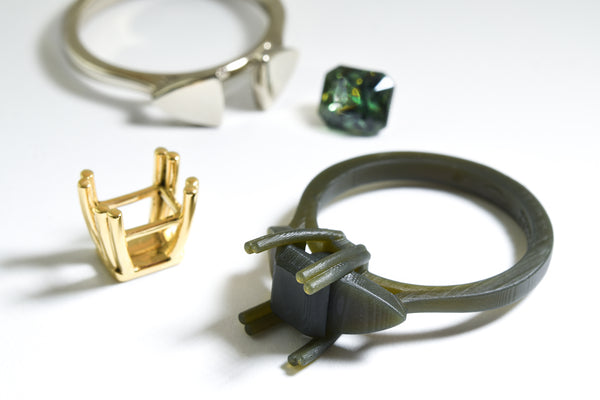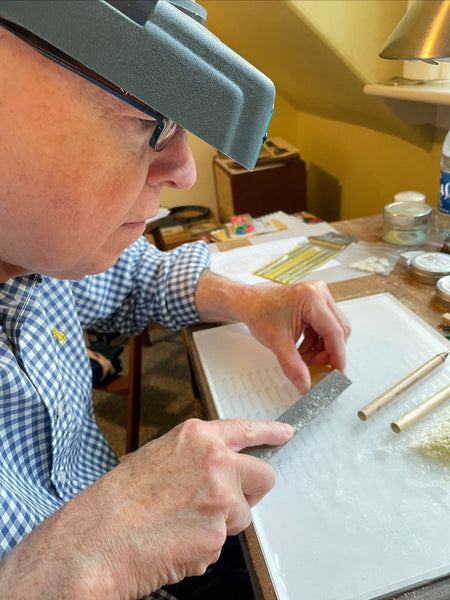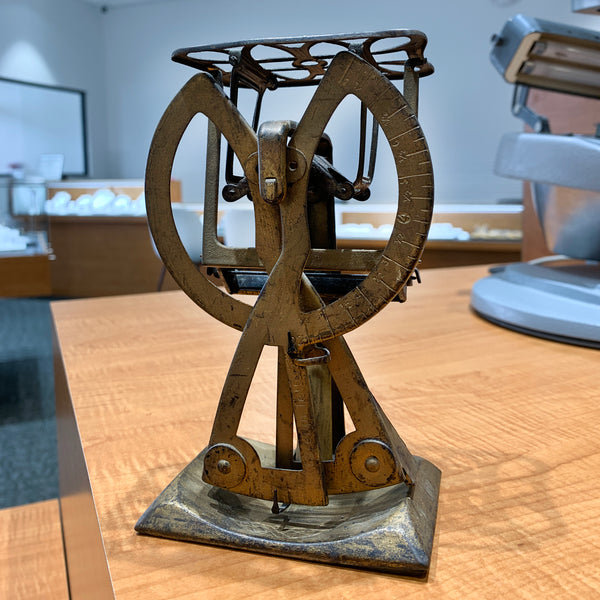Make This September Special With A Sapphire Birthstone: How To Find The Perfect Sapphire

Here at Plante Jewelers, the most popular colored gemstone is the sapphire. For a September birthday or a 5th or 45th anniversary, it’s the perfect present. Sapphires can be worn by everyone, regardless of when you were born!
This September birthstone comes in a wide variety of colors from the traditional blue sapphire, to pink-orange padparadscha. It symbolizes purity and wisdom, and has been considered one of the most precious of gems since the dawn of civilization. The gorgeous blue color is sapphire’s claim to fame, but there’s so much more to learn about this precious gem! Below we’ll talk about the history of the sapphire, along with buying tips and other fun things to know about this intriguing birthstone.
Sapphire History and Lore
Throughout history, sapphires have been prized for their incomparable beauty, strength, and protective powers. Worn in ancient times for protection as well as for status and to denote wisdom, sapphires symbolize heaven, divinity, and eternal life.
One of the “Big Three” gemstones (emerald, ruby, and sapphire), sapphire has always been treasured as a gemstone of nobility and divine favor. It has been a talisman for many religions—worn by the Greek oracles, Christian prelates, and by the Buddhists who prized it for calming them during meditation. People instilled sapphires with the power to make peace between enemies and guard chastity.

Widely associated with royalty, sapphires have decorated the robes of clergy members for hundreds of years to symbolize heaven. A stone of truth, faithfulness, and sincerity, the sapphire is especially ideal for engagement rings. Its extraordinary color is the standard against which other blue gems—from topaz to tanzanite—are measured.
Star sapphires exhibit a star-like phenomenon called asterism—inclusions within the crystals, known as “silk,” reflect light in a pattern of rays that resemble a star. These sapphires have long been associated with power and desirability. Helen of Troy owned a large star sapphire, and she also had dozens of suitors. Surely she treasured her star sapphire for its beauty as well as its protective powers!
Sapphire Colors
- Sapphire is a gemstone specimen of the mineral corundum. Corundum is a hard mineral that is used for industrial purposes. When it occurs in transparent, colored crystals, it is known as sapphire.
- Sapphires can be blue, yellow, purple, green, black, pink, orange, peach, or white. There are no red sapphires; red gemstones of this mineral are called rubies.
- One exceptional color for sapphire is the padparadscha, a lovely orangish-pink. The name is Sinhalese for “lotus blossom.” Padparadschas from Sri Lanka are the most beautiful, and the most rare. The most expensive sapphires in the world are the finest blues, along with the padparadscha.
- Blue sapphire can be a deep, velvety blue, or a bright, cornflower blue. Some sapphires can change in color from blue to purplish-blue when viewed under different kinds of light. They may also be teal-blue, or bi-color, showing zones of green and blue, or yellow and blue. There’s a blue sapphire for everyone!
- Yellow sapphire is sometimes pale, like a yellow diamond, or a deeper gold hue. Paired with white diamonds, it has a light, bright sparkle.
- Pinks can range from deep magenta to pale, soft pink, or even peach. Some pink sapphires have a slight lavender tint.
One of the interesting qualities of sapphire is that it is dichroic, meaning that its color can vary when the gemstone is viewed from different directions. Viewed one way, it may appear violet-blue, and from the other direction, it may look greenish-blue. Skilled cutters will take this into account, and cut the gemstone to preserve the richest violet-blue color. Especially with larger pieces of rough material, the cutter will cut to maximize the color. The finished gemstones are not standardized in size and proportion. This creates a highly individual gem that shows the most saturated color.

The most highly desirable sapphires come from Kashmir, where they are only found a few months of the year in the Himalaya mountains. They boast a velvety appearance and bright coloring. Montana sapphires have their own look—they are usually a lighter steel blue or teal in color. They are currently popular in sapphire engagement rings.
Today, Sri Lanka continues to be the source of the most prized sapphires. Madagascar is also a significant source. Sapphires are also mined in India, Myanmar, Vietnam, and of course in North America—specifically Montana.
The vast majority of sapphires are treated using heat to create a more brilliant hue. One percent or less of sapphires are gem quality when they are first taken from the earth. Those untreated sapphires are rare and valuable.
Famous Sapphires
Princess Diana’s blue sapphire engagement ring—In 1981, Prince Charles presented Lady Diana Spencer with a 12-carat oval blue sapphire, cut into facets and surrounded by fourteen solitaire diamonds. Prince William gave the stunning ring to Kate Middleton to seal their engagement in 2010.
The Rockefeller Sapphire—Named after its one-time proprietor, John D. Rockefeller Jr., the Rockefeller Sapphire is a 2.02-carat internally flawless cornflower blue sapphire.
The Stuart Sapphire in the Imperial Crown—Weighing in at 104 carats, the Stuart Sapphire forms part of the British Crown Jewels. It was passed down through the royal families, until finally coming into the hands of Henry Benedict Stuart, hence the stone’s name.
Star of Bombay—A182-carat star sapphire from Sri Lanka, the Star of Bombay was given to silent film star Mary Pickford by her husband, Douglas Fairbanks, Sr.. In 1981, she bequeathed it to the Smithsonian Institute. It’s the namesake of Bombay Sapphire, a gin manufactured in Britain.
Tips for Buying Sapphire Jewelry
- White sapphires are sparkly and can make a wonderful alternative to diamond, whether as an accent to another colored gem, or as the center of a significant ring.
- One of the reasons for the popularity of sapphires is their durability. With a hardness of 9 on the Mohs scale, a sapphire is safe for everyday wear. This makes it a great choice for an engagement ring or fashion ring that you’ll wear every day.

- Genuine sapphires are usually heated to improve color saturation. This is a safe, permanent treatment that has been used for centuries. A small percentage—about one percent—of rough sapphires are beautiful enough to be simply cut and polished without heating. These untreated sapphires are more costly.
- Synthetic sapphires are less costly than natural sapphire from the earth. When purchasing, be sure to be informed about what you are buying.
- Highly saturated blue, intense pink, and padparadscha sapphires are the most expensive. For a fine blue, choose a gemstone with no grayish tones.
- If you are choosing a loose sapphire, enjoy the variety of color tones and shapes that are unique to each gem.
- A large sapphire gemstone will probably require a custom setting because of the somewhat free-form cutting that is employed to maximize the depth of color. For example, a large sapphire will usually have a deeper pavilion (the lower part of the gemstone) than smaller gems or diamonds.
- Check to see that the color tones of the gemstones are well-matched. Diamonds always look pretty with sapphires—they add contrast and sparkle. Many other colored gemstones combine in interesting ways with sapphires. Some traditional combinations are sapphires with moonstones or emeralds. And of course, sapphires with sapphires in a rainbow style pendant or bracelet is a timeless choice.
- Rough sapphire beads—small ones in strands and tassels, or larger ones mixed with metal or other gemstones—are a more casual way to enjoy this perennial favorite of the gem world.
Caring for Sapphires
Most sapphires can be safely cleaned in an ultrasonic machine and steamer. If in doubt, take the safest route and use a soft toothbrush with mild soap and water, rinse, and air dry. Store it as you would any fine jewelry, kept separate from other pieces that may scratch it.

Sapphire jewelry is truly heirloom-worthy, and can be treasured and handed down for generations. If you have inherited a piece of jewelry with sapphires that have become abraded over time, they will look dull on the surface. This can happen to any gemstone, especially inherited jewelry that has been worn for many years. We can resurface your sapphire and make it look new again!
Plante Jewelers offers a lovely selection of beautiful sapphire birthstone jewelry to match your personal style. Find the best option for you or a loved one. Visit our jewelry store in Swansea to check out our collections. We have new gemstones coming in all the time, or we can find something unusual for you.
Leave a comment
Comments will be approved before showing up.







Nancy Plante
Author